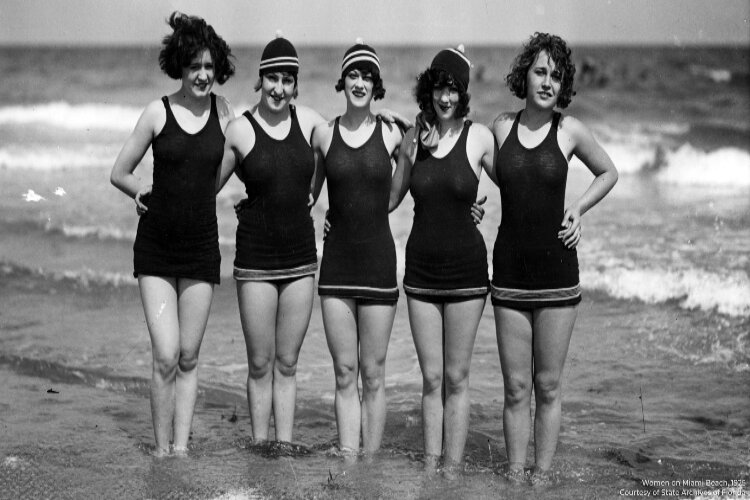“Decade of Change: Florida in the 1920s” foxtrots into the Tampa Bay History Center
The Tampa Bay History Center's new exhibit, "Decade of Change: Florida in the 1920s," journeys into a time period that played a significant role in shaping the modern-day Sunshine State and Bay Area.
At the Tampa Bay History Center’s new exhibit, “Florida in the 1920s, the Decade of Change,” visitors can learn how to do the foxtrot.
“We decided (that) one way to get people engaged in the musical trends of the 1920s is, let’s create a dance floor,’’ says Saunders Foundation Curator of Public History Brad Massey. “And then we’ll put dance steps on the dance floor itself and then people can play a foxtrot that was popular in the 1920s and they can dance to it. So the song we picked is called, ‘You Better Keep Babying, Baby.’Press the button, it plays and you do a foxtrot.”
The 1920s stands as Florida’s decade of change for a couple of reasons, Massey says.
“It’s when Florida gets more heavily populated,” he says. “People are moving down to Florida; they’re buying residential homes. And the Florida that you see today starts to take shape when it comes to the downtowns in Florida, when it comes to the suburbs like Tampa’s Davis Islands. This is the first time you see these very robust suburbs. You had suburbs earlier but then they really start to take off in the 1920s.’’
“The other interesting thing about the 1920s is the fashion, the dance, the music; it’s the first modern decade,” Massey adds. “You can listen to that music and watch those films and, obviously, they’re 100 years old, but they speak to the era we’re living in.’’
Opening November 4th, the exhibit covers the issues and culture of the era, such as the flourishing bootlegging trade in the wake of Prohibition; the architecture of that era in Tampa, with its Mediterranean revival and bungalow styles; plus social movements and politics. About 100 artifacts and plenty of photographs of the time are on display. One picture shows a bust of bootleggers transporting their spirits in a celery truck. The blueprints for the construction of the Tampa Theatre in 1926 are also on display.
Visitors will also see a safe from the speakeasy called Sloppy Natz Cafe, a collection of records from the 1920s, including Edison records, and a 100-year-old watercolor rendering of the Tin Can Tourists camp at Tampa’s Desoto Park on McKay Bay. Two swimsuits in the collection show the daring emergence of bare skin at the seaside.

“We thought well this is really interesting,’’ Massey says, “because the 1920s is the moment when a lot of the old school swimwear, where the bloomers that covered people’s legs with the full long sleeves that covered almost their entire body, that all goes away and then all of a sudden you see swimwear that’s reminiscent of today. You don’t see bikinis and things like that but you see one pieces that show thigh, that show arms, and it really paves the way to the modern swimsuits.’’
The show also addresses the Jim Crow era of rampant racial discrimination against Black people.
“When it comes to Jim Crow, what we see in the 1920s is the second birth of the Ku Klux Klan, and the Klan is going to have about 60,000 members here in Florida, so it becomes a statewide institution,” Massey says. “We have a membership card from the Klan.”
“Then of course there was the Black community reacting to this,” he says. “We have a press block from the Tampa Urban League that they used on some of their printed materials. Really influential Black residents like Blanche Armwood, who of course was an educator, and others are going to be involved in Tampa’s Urban League. So we tell that story of Black resistance to what was going on in Florida in the 1920s.”
The decade marked the rise of charismatic forms of Christianity like Pentecostalism, he says. Tent revivals worked the worshipers into a frenzy of devotion. The nationally popular evangelist Billy Sunday made appearances in Tampa in 1919 and again during the 1920s. Visitors can listen to an excerpt from one of his sermons.
An accompanying exhibit, “Sharps & Marks in Paradise: Selling Florida in the 1920s,” covers the Florida land boom and bust during the decade. Rodney Kite-Powell, director of the Touchton Map Library, will discuss the boom and bust with the aid of maps that show the development of South Florida and the Tampa Bay area.
He likens the rise and collapse to a Ponzi scheme, in which a lot of people bought “binders,’’ or options to buy property at a certain price, and then sold the option to someone else on the speculation that the land would be more valuable as the boom continued.
“When enough people realize that’s not the case, then you start losing faith in that process and you stop making payments, you stop trying to buy those binders, everything comes to a halt,” Kite-Powell says.
The boom started in Miami in 1921 and began in Tampa in 1924, he says. The collapse happened in late 1926 and early 1927.
Looking at the maps of the era, the most dramatic maps in the exhibition show the entire state at the time and its dearth of people.
“You’ve got the cities along the east coast that follow Flagler’s railroad and you’ve got a few on the southwest coast, places like Naples or Boca Grande,” Kite-Powell says. “But you don’t have a whole lot of roads and you just don’t have a whole lot of towns. Seminoles were living down there, and, really, this is when they kind of re-emerge as a known people, as the Tamiami Trail cuts through the Everglades.’’
Massey and Kite-Powell will discuss the exhibits in a lecture from 6:30 p.m. to 7:30 p.m. on Nov. 15 in TECO Hall at the Tampa Bay History Center. The event is free but registration is required.
To register for the November 15th talk, go to Florida Conversations: Florida in the 1920s.
For more information on the exhibit, go to Decade of Change: Florida in the 1920s.
















